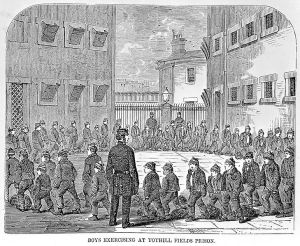“News of a shocking domestic tragedy comes from Sparkhill, near Birmingham. On Monday night, groans were heard coming from a field between Hall Green and Sparkhill, and later, when a search was made, the Warwickshire police found the bodies of Edward Birch, 35, an ironplate worker, living at Balsall Heath, and his stepdaughter Carrie Jones, 18.” (Nottinghamshire Guardian, Saturday 12 January 1895, page 8)
The tragedy in south Birmingham on the night of Monday 7 January 1895 had all the markings of a penny dreadful. A teenage girl, having an affair with her stepfather – the two overcome either by guilt or the inability to be together properly to embark on a suicide pact. Both parties had drunk carbolic acid before Edward Birch cut Carrie’s throat, and then his.
*
Selina Jane Birch was Carrie’s mother. She was somewhere between 34 and 38 at the time of the deaths, and Edward Birch, her second husband, was 38 (not 35, as the press reported).
Selina was born in Gloucester around 1860 (although the censuses give her approximate year of birth as anything between 1857 and 1863), but spent much of her life in Birmingham. Nothing is known of her first husband, and little of her marriage to Edward Birch – the records do not enable a definitive name or date (if you know more, do contact me!).
But by 1881, Selina and Edward were married – or stated to be – and living at 23 Aberdeen Street in Birmingham. There were two children at this point – Carrie, listed in the census as “Caroline Birch”, and one-year-old Alfred, who had been born in Edward’s home town of Wolverhampton.
Five more children – William, Lilly, Sidney, Herbert and Olive – came along between 1882 and 1894, with the family dependent on Edward’s income as a tin plate worker. Edward took to drinking heavily, and although ‘reasonably affectionate’ towards his wife when sober, was violent when drunk.
He also appears to have resented having to maintain a child that wasn’t his, or tried to convince others that he resented it, but he gradually developed feelings for his stepdaughter that were not the result of a parental love.
He fell for her; his feelings aroused deep jealousy of her relationships with other boys her own age, and he appears to have been a controlling, insecure man who struggled with his emotions and the complexity of his life.
Meanwhile, Selina Birch, although busy with looking after her many children, noticed the closeness between Edward and Carrie, and was uneasy. She tried to convince herself that they simply had a close father-daughter relationship, and that there was nothing improper between them.
But she remained suspicious. In October 1894, a letter arrived for Carrie, asking to make an appointment with her one evening. On that date, she watched the couple closely, and accused Edward of having had the letter written on his behalf, but he denied it.
*
It was late on a Monday evening when people walking down Springfield Road between Hall Green and Sparkhill heard groans coming either from a house or the neighbouring field. It had been snowing, and the night was cold.
Although nobody thought to call the police, one anonymous person did notify the local doctor, who then told the constabulary. Sergeant Wright undertook a search, and soon found the dead body of Carrie Jones, with a two inch wound to her throat, and next to her, Edward Birch, still breathing, but with a cut throat and smelling of carbolic acid.
He was removed in a ‘conveyance’ to the Queen’s Hospital in Birmingham, where he died at around midday the next day.
The carbolic acid had had a corrosive effect on his tongue, gullet, stomach and intestines, and he had died of shock caused by carbolic acid poisoning.
Part 2 of the Hall Green Tragedy will be posted here tomorrow.













